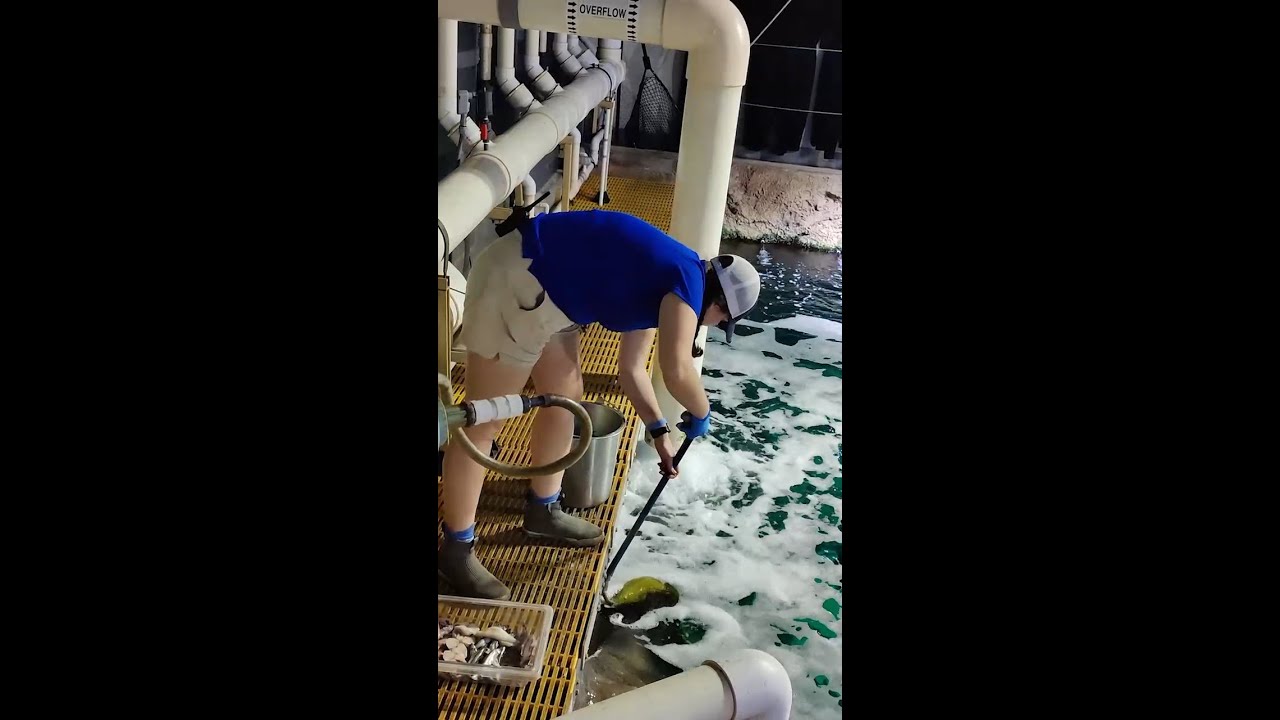– An inside look at the feeding habits of the green moray eel at the National Center for Aquatic Freshwater (NCAFF)
– Insights into the role of an aquarist in the careful maintenance and care of aquatic species
– The excitement and science behind the scenes of a popular marine exhibit
– How guest interactions contribute to educational experiences in marine biology
Have you ever wondered how a twisted creature of the sea with a mysterious aura captures its prey? Or perhaps you’ve pondered about the individuals whose daily routines involve caring for such enigmatic beings. Today, we dive into the deep blue to observe the riveting spectacle of the green moray eel’s feeding time at the National Center for Aquatic Freshwater (NCAFF).
The world beneath the waves is nothing short of extraordinary, each creature an integral thread in the aquatic tapestry. Among these marine marvels slithers the green moray eel, a resident of coral reefs and rocky crevices. Though their color seems to suggest a verdant hue, these eels are covered in yellow mucus over dark blue skin, which gives the illusion of a green appearance.
Now, let’s take a closer moment to appreciate the efforts of Aquarist Sarah, whose pivotal role at NCAFF is. An aquarist is akin to a conductor of an underwater symphony, ensuring each species thrives in its controlled environment. Sarah, armed with knowledge and a profound passion for marine life, prepares special meals that cater to the dietary needs of these slithery sea dwellers.
Green moray eels are unique, and their feeding habits resemble nature’s ingenuity. They are stealthy predators in the wild, reliant on the cloak of the ocean’s darkness and their adept ambush skills. These carnivorous creatures feast on various sea life, from small fish to crustaceans. Their approach to mealtime is one of patience, waiting for an opportune moment to lunge at their unsuspecting prey with remarkable swiftness.
What makes the feeding at NCAFF a must-see is the chance to witness one of nature’s intriguing predators in action and the care and precision with which it is carried out. Aquarist Sarah’s routine is a delicate dance of nourishment and nurture – a calculated approach to providing sustenance while respecting the natural behavior of the green moray. It’s an art and science, balancing the dietary requirements with the need to stimulate the eel’s instincts, ensuring both physical health and mental well-being.
Behind the scenes of this seemingly straightforward act lies a tireless pursuit of knowledge and understanding. Each feeding session is more than just a food delivery; it’s an opportunity to observe the eel’s health, behavior, and well-being. As guests at NCAFF, you witness more than a meal; you witness the care, research, and environmental stewardship that goes into preserving the magnificent biodiversity of our oceans.
Like all aquarists, Sarah Sarah is a silent hero in wildlife conservation. Her work goes beyond feeding to include maintaining water quality, monitoring tank conditions, and documenting the health and behavior of aquatic residents. The attention to detail and dedication required to keep such a complex ecosystem thriving are monumental.
But feeding the green moray eel isn’t just about observation – it’s an educational experience. At this moment, visitors can learn about marine ecology, the importance of conservation, and the marvels of natural adaptation. As Sarah feeds the eel, she also nourishes the minds of onlookers, explaining the intricacies of marine life and its delicate balance within our planet’s ecosystems.
Every nibble and every movement the eel makes is an expression of natural behavior that biologists study to better understand how to protect these creatures in the wild. Through active engagement, guests leave with memories and a deeper appreciation of the vital roles each species plays in the ocean’s health.
The NCAFF provides a sneak peek into the unseen world below the ocean’s surface, inviting curiosity and fostering a connection between humans and the aquatic environment. When we observe the likes of Sarah and her green moray eel, we become witnesses to the emotional and intellectual ties that bind us to the vast aquatic universe.
Moreover, the captive dietary habits of green morays reflect the meticulous work that marine biologists carry out in the name of ecological balance. Specialists like Sarah must adapt feeding practices to mimic natural conditions as closely as possible, ensuring that the eels engage in instinctual behaviors.
The fascination with the green moray eel’s feeding time symbolizes a significant human quest for understanding and symbiosis with nature. The careful orchestration of every morsel offered and every sudden strike reminds the intricate web of life that calls our oceans home.
As guests absorb the drama unfolding before them, each one leaves armed with knowledge and a stirring call to action. Protecting our environment starts with awareness and respect for even the most seemingly alien creatures among us. Sarah’s work, coupled with NCAFF’s educational mission, inspires a ripple effect that extends far beyond the walls of the aquarium.
Enthralled audiences carry the torch, igniting conversations about marine conservation, the perils of oceanic pollution, and the ethical treatment of living beings beneath the waves. Witnessing the feeding ritual of the green moray eel, they become ambassadors for the silent, submerged world and its precious, fragile inhabitants.
Ultimately, the Eel feeding at NCAFF is a convergence of passion, science, and education. It is a delicate and complex choreography of care that ensures that even within our human domain, creatures like the green moray eel can thrive while enlightening us about the pressing need to preserve their natural habitats. Within this watery realm of calm observation and silent understanding, we, too, can find our connection to the planet and the mysterious life it cradles.
*****
Source Description
Sneak peek!
Check out Aquarist Sarah feeding our green moray eel. #SnackTime #NCAFF

